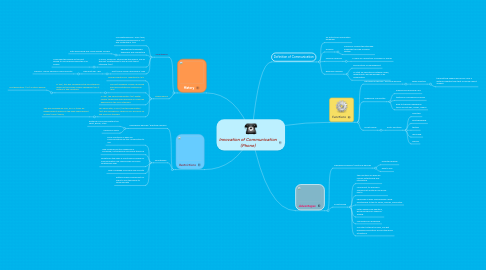
1. History
1.1. Smartphone
1.1.1. Conceptualized by Tesla 1909, Theodore Paraskevakos in 1971 and patented in 1974
1.1.2. Devices that combined telephony and computing
1.1.2.1. Data processing and visual display screens
1.1.3. In 2007, Apple Inc. introduced the iPhone, one of the first smartphones to use a multi-touch interface (iOS)
1.1.3.1. 2008 saw the release of the first phone to use Android called the HTC Dream
1.1.4. First touch screen launched in 1993
1.1.4.1. Manufacturer : IBM
1.1.4.1.1. Devices : Simon Personal Communicator
1.2. Mobile phone
1.2.1. Finnish inventor Eric Tigerstedt in 1917
1.2.2. The first handheld mobile cell phone was demonstrated by Motorola in 1973
1.2.2.1. In 1981, this was followed by the simultaneous launch of the Nordic Mobile Telephone (NMT) system in few conutries
1.2.2.1.1. First generation ("1G") systems appear
1.2.3. In 1991, the second generation (2G) digital cellular technology was launched in Finland by Radiolinja on the GSM standard
1.2.4. Ten years later, in 2001, the third generation (3G) was launched in Japan by NTT DoCoMo on the WCDMA standard
1.2.4.1. This was followed by 3.5G, 3G+ or turbo 3G enhancements based on the high-speed packet access (HSPA) family,
2. Restrictions
2.1. Mechanical Devices / Electrical devices
2.1.1. distance of communicate is too short, 800m, 21km
2.1.2. mechine is fixed
2.2. Smartphone
2.2.1. some functions or apps for communication are too complicated to use
2.2.2. new modules are too expensive in somehow, not everyone can afford the price
2.2.3. sometimes the apps or functions provided for communication are unnecessary for every smartphone user
2.2.4. Risk of leakage of privacy and security
2.2.5. battery maybe insufficient for users to use the phone to communicate
3. Functions
3.1. Mechanical Devices / Electrical devices
3.1.1. single function
3.1.1.1. transmitting speech and music over a distance greater than that of normal direct speech
3.2. Telephone Transmitter
3.2.1. making and receiving calls
3.2.2. texting or messaging someone
3.2.3. hard to transfer message in terms of pictures, voices, videos
3.3. Smart Phone
3.3.1. multi-functions
3.3.1.1. shooting
3.3.1.2. photographing
3.3.1.3. texting
3.3.1.4. recording
3.3.1.5. filming
4. Advantages
4.1. Mechanical Devices / Electrical devices
4.1.1. unlimited energy
4.1.2. easy to use
4.2. Smart Phone
4.2.1. the functions or apps are usually entertaining and interesting
4.2.2. convenient to approach someone at anytime you would like to
4.2.3. necessary in daily life especially using smartphone to talk to family, friends, classmates
4.2.4. outer designs are beautiful, giving someone a superior feeling
4.2.5. Necessary for workplace
4.2.6. Constant Internet Access, can get knowing information around the world at anytime
5. Definition of Communication
5.1. An activity for information exchange
5.2. Purpose
5.2.1. convey or receive the intended meanings through a shared system
5.3. General meaning
5.3.1. A mean of connection of people or places
5.4. Business meaning
5.4.1. Key function of management
5.4.2. To start up operations between levels, departments and employees in an organization

